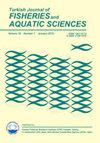Biological Characteristics of Siraz Fish, Capoeta kosswigi (Teleostei: Cyprinidae) and Host Relationship with Ectoparasitic Glochidia Larvae of Freshwater Mussel, Unio stevenianus (Bivalvia: Unionidae) in the Karasu River (Van, Türkiye)
IF 1.7
4区 农林科学
Q3 FISHERIES
引用次数: 0
Abstract
Capoeta kosswigi (Karaman, 1969) and Unio stevenianus (Krynicki, 1837) are endemic species in the Karasu river, the Lake Van basin. This study was carried out to determine the biological characteristics of C. kosswigi and distribution and prevalence of U. stevenianus glochidia on this host fish. A total of 379 C. kosswigi were caught by electrofishing between March 2022 and February 2023. The maximum fork length and total weights of C. kosswigi were 29.2 cm and 421.8 g for females and 27.8 cm and 337.9 g for males. The length-weight relationships were calculated as W=0.017L2.881 (r2=0.986) for males (negative allometric growth) and W=0.016L3.001 (r2=0.953) for females (isometric growth). The Fulton condition factor was determined as 1.53±0.13 (1.23-1.99). The female:male ratio was calculated as 0.18:1.00. Additionally, a total of 12525 Unionid glochidia were detected on C. kosswigi samples in this study. Glochidia was more inclined to prefer male C. kosswigi as a host. The highest amount of glochidia was recorded in May, while the lowest in August. The amount of glochidia was statistically found the highest in the gill filaments (454.3±678.0) compared to all fins. Therefore, the native species, C. kosswigi is a suitable host for the freshwater mussel, U. stevenianus.卡拉苏河(土耳其凡城)中西拉鱼 Capoeta kosswigi(远洋鱼类:鲤科)的生物学特征及与淡水贻贝 Unio stevenianus(双壳纲:Unionidae)的外寄生性 Glochidia 幼虫的寄主关系
Capoeta kosswigi(Karaman,1969 年)和 Unio stevenianus(Krynicki,1837 年)是凡湖流域卡拉苏河的特有物种。本研究旨在确定 C. kosswigi 的生物特征以及 U. stevenianus 珠虫在该宿主鱼类上的分布和流行情况。2022 年 3 月至 2023 年 2 月期间,通过电鱼共捕获了 379 条 C. kosswigi。雌鱼的最大叉长和总重分别为29.2厘米和421.8克,雄鱼的最大叉长和总重分别为27.8厘米和337.9克。经计算,雄鱼的体长-体重关系为 W=0.017L2.881 (r2=0.986) (负异速生长),雌鱼的体长-体重关系为 W=0.016L3.001 (r2=0.953) (等速生长)。富尔顿条件因子确定为 1.53±0.13 (1.23-1.99)。雌雄比例为 0.18:1.00。此外,本研究在 C. kosswigi 样品上共检测到 12525 个 Unionid 球虫。钩毛虫更倾向于以雄性 C. kosswigi 为宿主。五月份的钩毛虫数量最多,八月份最少。据统计,鳃丝中的钩毛数量(454.3±678.0)比所有鳍中的最高。因此,本地物种 C. kosswigi 是淡水贻贝 U. stevenianus 的合适宿主。
本文章由计算机程序翻译,如有差异,请以英文原文为准。
求助全文
约1分钟内获得全文
求助全文
来源期刊

Turkish Journal of Fisheries and Aquatic Sciences
FISHERIES-MARINE & FRESHWATER BIOLOGY
CiteScore
3.10
自引率
0.00%
发文量
43
审稿时长
3 months
期刊介绍:
Turkish Journal of Fisheries and Aquatic Sciences" (TrJFAS) is a refereed academic journal has been published by Central Fisheries Research Institute of Turkey and Japan International Cooperation Agency (JICA), and published in English.
It aims to address research and needs of all working and studying within the many varied areas of fisheries and aquatic sciences.
The Journal publishes English language original research papers, critical review articles, short communications and technical notes on applied or scientific research relevant to freshwater, brackish and marine environments.
TrJFAS was published biannually (April & November) between 2001 and 2009. A great number of manuscripts have been submitted to the journal for review from acceptance of the SCI index. Thereby, the journal has been published quarterly (March, June, September and December) from 2010 to 2017. The journal will be published monthly in 2018.
 求助内容:
求助内容: 应助结果提醒方式:
应助结果提醒方式:


